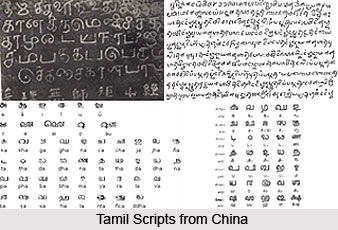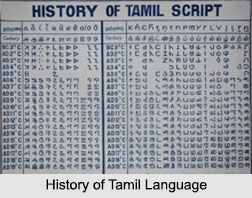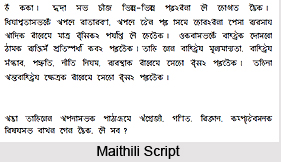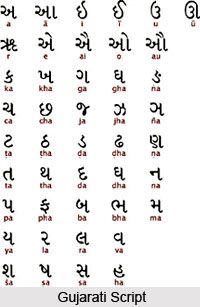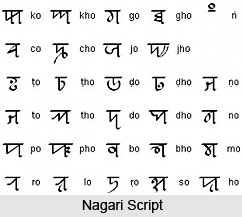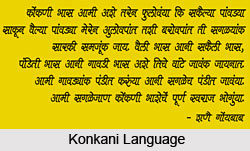 Konkani is an exuberant language, belonging to Indo-Aryan language group, widely spoken on the western coast of India, namely Konkan. Various states of India namely northern and central coasts of Maharashtra, Goa, Dadra and Nagar Haveli, Canara (coastal Karnataka) and also some provinces of Kerala are integrated to this whole of Konkan area and speak Konkani.
Konkani is an exuberant language, belonging to Indo-Aryan language group, widely spoken on the western coast of India, namely Konkan. Various states of India namely northern and central coasts of Maharashtra, Goa, Dadra and Nagar Haveli, Canara (coastal Karnataka) and also some provinces of Kerala are integrated to this whole of Konkan area and speak Konkani.
Thus quite a large number of people speak this beautiful language of Konkani. A report was brought out by `The Census Department of India` in the year 1991, which records that the number of Konkani speakers in India is 1,760,607. This population comprises of 0.21% of the total number of people residing in Indian subcontinent. It secures the position of being fifteenth in the comprehensive list of `Scheduled Languages`. It was recorded as per the total `strength` of people. Very recently, the ethnological record gave an estimation of 7.6 million speakers in the whole of the world.
The evolution of Konkani is quite significant. In the initial years of its inception, Konkani has developed as a popular language in Goa province. Although Brahmi script was used in the initial days, soon it paved the way for Devangiri script rampantly used for writing.
It was used widely for spiritual purposes and also for maintenance of accounts, trading ledgers and other daily chores.
The next era of the development of Konkani is largely embellished with the contributions of various communities. Various Konkani communities molded the Konkani language suiting their own viability. Muslim communities of the Konkan region of Ratnagiri and Bhatkal shaped the Konkani languages. Factors like inter caste marriages with Arab populace, changeovers of Hindus to Muslims etc have brought about these changes in the language. Some of them who have settled down in near by territories also implanted several modifications in their language and practices also. Thus in this way, during the last five hundred years, the Konkani language spread to various state provinces like Canara, Kokan-patta and Kerala etc.
In a whole, Three emigrational phases are marked that have resulted in this expansion of Konkani The first migration has occurred during the early years of Portuguese rule and the Inquisition of 1560s. The second phase of migration was during the great war of 1571 C.E. war , with Sultan of Bijapur as its initiator. The third phase of migration took place during the wars of 1683-1740 C.E. with the Marathas. If the first phase was largely due the Hindus migrants who escape from the religious persecutions, the second and third phases were largely attributed to Christian emigrants.
These migrant communities lived in comparative loneliness, each developing its own dialect. Since these communities had to interact with others in local languages on a daily basis, Konkani dialects show strong local influences in terms of script, vocabulary and also style.
Truly, the coming of Portuguese to the Indian soils brought about the sea changes of Konkani language. Their Christian norms and practices highly got mingled up among the Konkani speakers. In the beginning of Portuguese colonization, it was these Christian missionaries of Portuguese who felt the need of propagating their religion of Christianity in a way that the local people can easily understand. This venture of translating the literary works of Christians had begun by leaps and bounds.
In 1684 C.E, for the first time the Portuguese settlers imposed a ban on the usage of local languages in all the Indian territories that they have conquered, just to keep a halt on the possibilities of propagating religious dictums in Hinduism. Further to prohibit all ties of the inhabitants to their original cultural tradition, the settlers have imposed Portuguese as an official language, thus leading to a stable decline of Konkani. It no longer received the state patronage. The use of Portuguese moulds the Konkani to a large extent. Multitudes of upper class Christians used Konkani largely to interact with the lower classes, mainly using Portuguese in societal assemblies.
Meanwhile, the migrant communities outside Goa held Konkani lively, and the language got diversified shape.
The succeeding few years, the Konkani language was in a real deplorable state due to the dominance of not only Portuguese and also several other Indian languages like Marathi. Thanks to the initiative of a modern literate namely, Vaman Raghunath Varde Valaulikar, popularly known as Shenoi Goembab, Konkani language was revived.
He is regarded as the pioneer of modern Konkani literature, also took initiative of this revival by composing several writings in Konkani language.
Post-Independence era marks the next phase of Konkani evolution. With the absorption of Goa as Union territory and thus reinstating Goa along linguistic line, an issue cropped up whether to confer Goa as a separate state, not merging with Maharashtra and Konkani as an independent language. In the year 1967, when the fate of Goa as a separate state was affirmed by a `plebiscite`, Indian languages like English, Hindi and Marathi veered for official communication and Konkani was relegated.
In the following years, the issue regarding the status of Konkani language far fetched time and again. Due to continuous nagging of Marathi folks of delineating Konkani as a dialect of Maratha, rather than a separate language, resulted in bringing the issue to the floor of Sahitya Akademi. In order to resolve the matter, the then President Mr Sunit Kumar Chatterjee, allotted a Committee of linguistic experts. Ultimately, on February 26, 1975 was a landmark; on that very day, the Committee finally had bestowed upon the status of an autonomous and literary language to Konkani.
The following phase marked the struggle of Konkani people of Goa continued to elevate the status of Konkani as official language. In the year 1986, they have even organized a mass agitation. Lastly, on 4th February 1987, the Goa Legislative Assembly approved the Official Language Bill making Konkani the Official Language of Goa.
Another milestone is that Konkani was incorporated in the `Eight Schedule of the Constitution of India`. It was as per the Seventy-First Amendment that was promulgated on 31st August 1992, thus adding up Konkani to the comprehensive list of National Languages. Even Konkani got so fame afterwards that Konkani written in Devangiri script was printed in a rupee note issued by an Indian bank.
Konkani is written in numerous scripts. In the beginning, Brahmi was used and afterwards, it was annulled. Devanagari is the official script for Konkani in Goa. Roman script is also far famed in Goa. The Konkani population of Karnataka uses the Kannada script. Malayalam script is also prevalent in the Konkani writings of the community, concentrated on several cities of Kerala like Cochin and Kozhikode . In coastal Maharashtra and also in Bhatkal taluka of Karnataka , Konkani Muslims make use of Arabic script in order to write Konkani.
Konkani has a wealth of numerous dialects. In fact each region has a diverse dialect, articulation style, words, tone and often noteworthy differences in grammar. Geographical diversity, religion, caste and unique speech techniques of localites have resulted in the development of so many dialects. Eminent researchers have categorized dialects and that too in a different way.
Mr Narayan.Govind Kalelkar has made the categories on the basis of historical incidences and cultural influences. Broadly speaking, thee major groups have been formed and these are as follows:
Northern Konkani comprises of dialects spoken in the Ratnagiri district of Maharashtra who have established cultural links with Marathis .
Central Konkani : It comprises of dialects of Goa, where Konkani was highly influenced by Portuguese language and culture.
Southern Konkani constituents of all the dialects of the Canara region of Karnataka having close link with Tulu and Kannada.
Ethnologue(ISO) too brought out its categorization. These are as follows:
The `ISO 639-3` assorts `Konkani generic macrolanguage(ISO 639-3:kok)` into `Goan Konkani (ISO 639-3: gom )`; `Konkani (individual language) (ISO 639-3: knn)`
This `ISO 639-3: knn` constitutes of numerous dialects and these are namely `Agari of Kolaba; Parabhi (Kayasthi, Damani); Koli; Kiristav; Dhanagari; Bhandari; Thakuri (Thakari, Thakri, Thakua, Thakura); Karhadi; Sangamesvari (Bakoti, Bankoti); Ghati (Maoli); Mahari (Dhed, Holia, Parvari);
On the other hand, the dialects that constitutes Goan Konkani (ISO 639-3: gom) are namely, `Sarasvat Brahmin`, `Standard Konkani (Goan)`, `Bardeskari (Gomantaki)`,
`Kudali (Malvani)`, `Mangalore`,`Daldi (Nawaits)`, `Chitpavani (Konkanasths)`.
`ISO 639-3` incorporates several languages and also dialects in the Konkani language. Although they may not be esteemed as dialects of Konkani, they are rightly considered to be sister languages.
